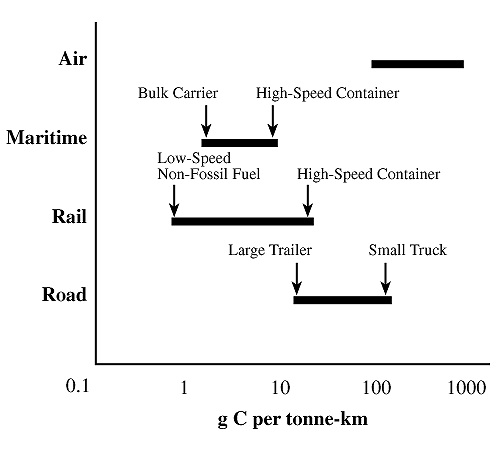
Although aviation is a relatively small industry, it has a disproportionately large impact on the climate system. It accounts for four to nine per cent of the total climate change impact of human activity.
But at a time when we urgently need to reduce our impact, greenhouse gas emissions from aviation continue to grow. For example, since 1990, CO2 emissions from international aviation have increased 83 per cent. The aviation industry is expanding rapidly in part due to regulatory and taxing policies that do not reflect the true environmental costs of flying. "Cheap" fares may turn out to be costly in terms of climate change.
Sign up for our newsletter
How do greenhouse gas emissions from flying compare with emissions from other forms of transport, like driving?
Compared to other modes of transport, such as driving or taking the train, travelling by air has a greater climate impact per passenger kilometre, even over longer distances (see graph below). It's also the mode of freight transport that produces the most emissions.
 CO2 intensity of passenger transport.
Note that if the upper atmosphere impacts of air travel were included,
emissions from air travel would be between four and nine times greater
than shown in this diagram.
CO2 intensity of passenger transport.
Note that if the upper atmosphere impacts of air travel were included,
emissions from air travel would be between four and nine times greater
than shown in this diagram.
What sorts of greenhouse gases do aircraft produce?
When jet fuel is burned, the carbon in the fuel is released and bonds with oxygen (O2) in the air to form carbon dioxide (CO2). Burning jet fuel also releases water vapour, nitrous oxides, sulphate, and soot.
A special characteristic of aircraft emissions is that most of them are produced at cruising altitudes high in the atmosphere. Scientific studies have shown that these high-altitude emissions have a more harmful climate impact because they trigger a series of chemical reactions and atmospheric effects that have a net warming effect. The IPCC, for example, has estimated that the climate impact of aircraft is two to four times greater than the effect of their carbon dioxide emissions alone.
What are "contrails" and what is their impact on climate change?
Contrails are the long plumes of exhaust that can be seen in the sky behind airplanes. They consist primarily of water droplets and ice, and are formed when water vapour released from burning jet fuel condenses at higher altitudes. Contrails may stay in the sky for many hours, and can spread two kilometres wide before dispersing. The net effect of these contrails is to trap heat that would otherwise escape from the Earth, which contributes to global warming. Studies have shown that night flights have the strongest warming impact, because during the daytime contrails actually reflect some sunlight away from the earth.
What's being done about emissions from air transportation?
Not much, unfortunately. Countries with national emissions targets under the Kyoto Protocol, like Canada, are only required to account for emissions from domestic flights. Emissions from international flights are not counted. And very little has been done to actually limit these emissions. To date the only formal plan to control and reduce international aviation emissions is being developed within the European Union (EU).
Is it likely that new technologies or fuels will make air transportation more efficient in the near future and help reduce its climate impact?
Currently, airplanes use kerosene fuel, and there is no indication that commercial aircraft powered by solar panels, batteries, biofuels, or hydrogen can be expected anytime soon. In terms of efficiency, it appears that improvements in current aircraft technology have nearly reached their limit, and further significant fuel-efficiency gains will only come from the development of radically new airplane designs and systems. The time, cost and coordinated effort it would take to develop and test such designs and then phase them into the world's fleets of aircraft make this unlikely to happen anytime soon. It is therefore an impractical solution for the urgent problem of climate change. In reality, the small, incremental gains that we can reasonably expect in aircraft fuel efficiency will be eclipsed by the projected growth in the industry.





